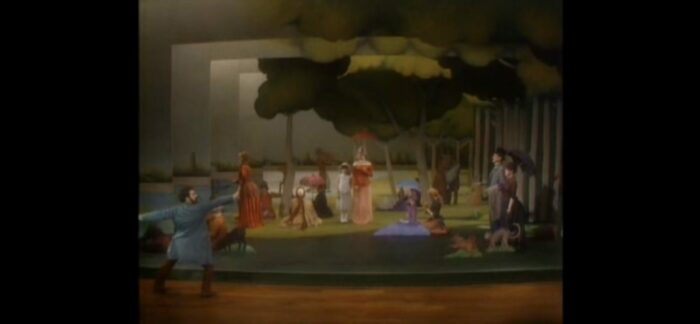Stephen Sondheim died this week. This in and of itself is not remarkable. He was 91 years old and it had been many years since his last new musical opened on Broadway. (Though he was working on a final show up until the day he died.) The man lived a great life and created some of the greatest art that will ever exist. And yet, as the accolades, obituaries, and acts of mourning have poured in from all over, the sadness of his passing threatens to overwhelm us.
Long ago Stephen Sondheim moved on from being a man to being a legend. But he was a living legend. People that knew him called him “Steve.” (Whereas I will only ever call him “Mr. Sondheim.”) This legend of the stage, a genius who in death is being unironically compared (justifiably) to Shakespeare, was also a person you could (and many many would) sit down and have a drink with.

New composers from Jonathan Larson to Lin-Manuel Miranda and many many more would go to sit at the altar of “Sondheim.” Inundating the master with their shows and ideas. Rather than disdain, these up-and-coming heirs to the throne would be met with genuine care, compassion, and advocacy. Sondheim always said, all the way up to the week before his death, that he was just trying to honor the legacy Oscar Hammerstein II left by being his mentor. He did that, of course, and so much more.
Musical Theatre is an odd art form. It is both insular and specific and universal. While a movie debuts around the world and can be played and replayed forever, the pinnacle of exposure for a musical is a limited production on one street in New York or one street in London. The show itself is replicated over and over, by revivals and high schools and cabarets and movies, but the essence of each show, the heart of it, has to lie in the material itself. It is a small niche, thriving on commercial appeal and Stephen Sondheim’s shows were never all that successful, even inside that tiny niche. But the art was universal and will be eternal.

With Sondheim’s death, his acolytes (me included) have been thrown down the rabbit hole of the work all over again. We may not be able to see Angela Lansbury and Len Cariou as Mrs. Lovett and Sweeney Todd, but we can listen to the cast recording and still gasp at the pause at the end of “Epiphany” that leads directly into the opening lines and first notes of “A Little Priest.” Or watch the inferior, though still amazing, production of the show with George Hearn taking over as the demon barber of Fleet Street. (The Tim Burton film is a problem all of its own.)
In one way or another, all of Stephen Sondheim’s shows can be revisited. Either via cast recordings, amazing books, or classic documentaries of their own. Personally, I would skip the film adaptations, except maybe A Funny Thing Happened on the Way to the Forum, which can give you a bit of Zero Mostel/Michael Crawford methadone and a shot of pure comedy for your healing pleasure. The rest of the Sondheim film canon, from Hal Prince’s far too cut down, but far too long and meandering version of A Little Night Music through the Rob Marshall Into the Woods, has never quite gotten the synergy right.

There are however current stage productions of Company and Assassins running in New York. These are not only all-time great shows, but they will be the last to actually have had input from the man himself. Both productions had been slated to open prior to the pandemic but were delayed until now. Most of the casts returned and Sondheim not only saw the openings of both before his passing, but he was also still quite involved with them.
Sondheim was always fascinatingly hands-on with productions. The work always had amazing directors and other creatives but he felt a great responsibility to the piece and helped the performers craft their characters himself. I personally saw him jump out of his seat and start pacing in the back of the house at the Richard Rodgers Theatre during the first preview of the 2005 John Doyle Sweeney Todd revival. Lauren Molina, who played Johanna in that production and has also stared in Sondheim’s Assassins, A Little Night Music, and the exquisite Keen Company’s mounting of his Marry Me A Little, among her many other fascinating musical endeavors, once told me, “Working with Steve is a delight, it is exactly what you hope it would be, which is overwhelming and amazing.”

There are countless stories out there of actors and creators who have had those types of interactions with the man. Sondheim’s love for the craft, and his dedication to helping those in it, shines through all the sadness around his death. It always comes back to the shows themselves. These shows have their own story to tell, and a million more will be told for hundreds of years to come using his material, but if you can make it up to see a show, then you still have some chances to be touched directly. (Though I do hold out hope that they got some sort of input from Mr. Sondheim for Richard Linklater’s 20 years in the waiting film version of Merrily We Roll Along.)
Amazingly there are also two movies either out or releasing soon that are Sondheim-centric. Sondheim himself is a character in Tick, Tick…Boom!, played by the great Bradley Whitford. TTB is Jonathan Larson’s autobiographical show, tinged with the sadness of his early death, and Sondheim is a pivotal figure in it and around it. It is also directed by Lin-Manuel Miranda, really completing the cycle of connection. Then of course is Steven Spielberg’s new adaptation of West Side Story. The movie seems poised to be a big, nostalgic, centerpiece. (And hopefully a star vehicle for the amazing Ariana DeBose.) But at the center, once again, is Stephen Sondheim. Try to think about how amazing that is in a vacuum—somehow this one person, who was alive in 2021, wrote the lyrics to West Side Story. (Even though he often said he was unhappy with his work.)

In all of the extraordinary art that Sondheim created, it is possible that the coup de grace, the absolute tip-top, is Sunday in the Park with George. SITPWG has long been considered an autobiographical piece. The artist delves into the life of an artist and gives his own creations new life and then, even within the show itself, the passage of time and commercial tastes change the meaning of what it even means to be an artist.
“The art of making art is putting it together. Bit by bit.” This great show is perhaps difficult for some people to get into. The themes are deep and blisteringly sad, but the music is also some of the most alive, hopeful melody that has ever been made. If you don’t have the DVD, it is possible to stream the recording of the show from 1985 with Bernadette Peters and Mandy Patinkin, and really everyone who has read this far should just stop now and do just that. We all may have to “Move On” someday, but Stephen Sondheim left behind the greatest gifts of art we can imagine, and we should celebrate that. Forever.

There is a greatness to experiencing art, a closeness to the essence of creation and what makes us human. Only the most exceptional of people can bring on that closeness with any consistency. In life and in art, Stephen Sondheim was one of those rare few. For those that knew him, those that met him as a passing in the night, or those that will only ever meet the light and greatness of the work he left behind, we are all the better for having had him in our midst. “Everything was possible, and nothing made sense.”
Also, I’ve never seen it, but there is a recording for Japanese TV of Pacific Overtures complete with Mako as the Reciter. (And if you can’t understand why that sentence makes me swoon, “well Jed, I don’t really want to know you.”)


